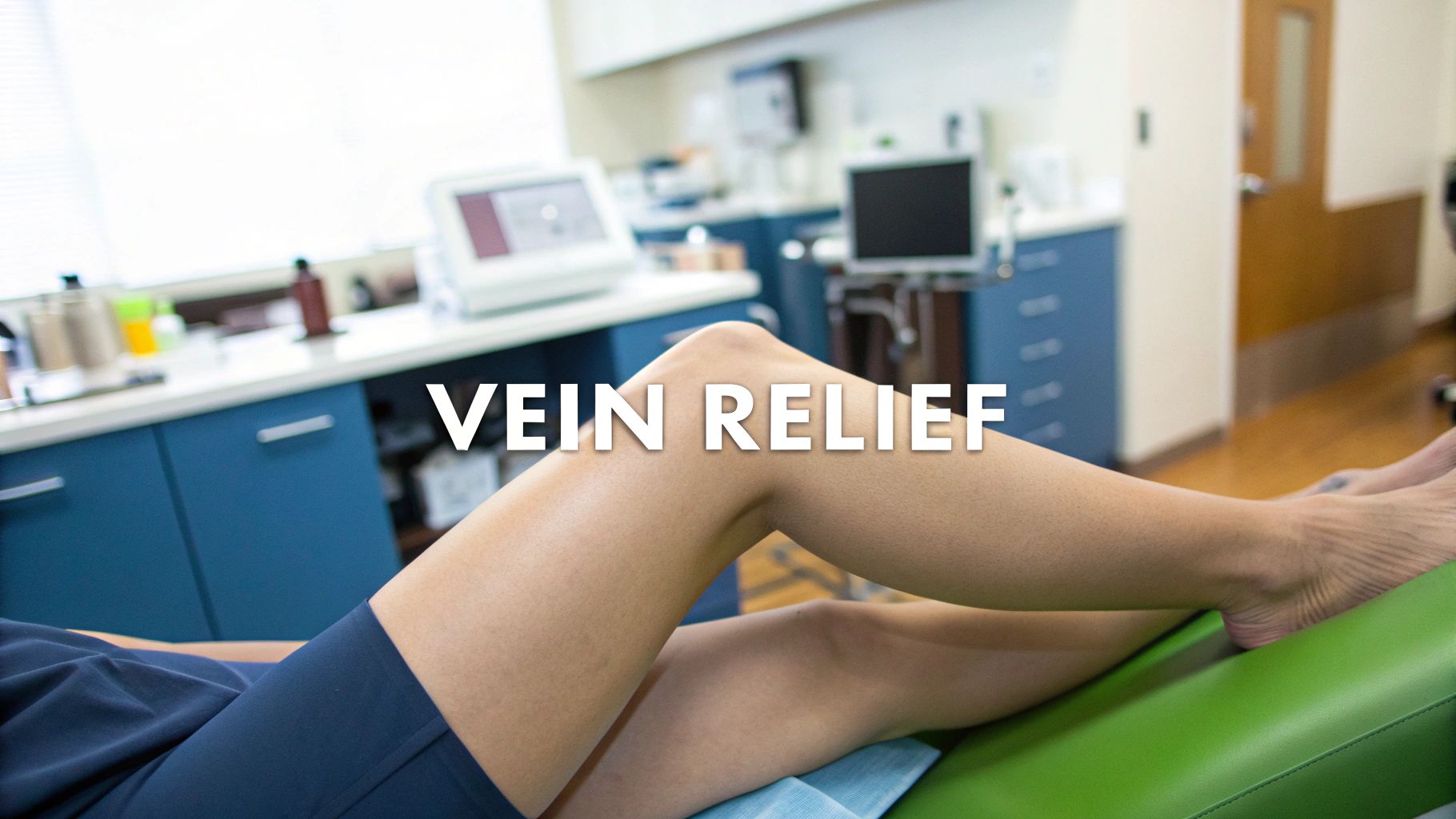.webp)
If you’re struggling with the achy, heavy feeling or the appearance of varicose veins, you’re far from alone. In fact, an estimated one in three adults in the UK will develop them at some point. These bulging, often blue or purple veins are more than just a cosmetic nuisance—they’re a sign that your circulation isn’t working as efficiently as it should be.
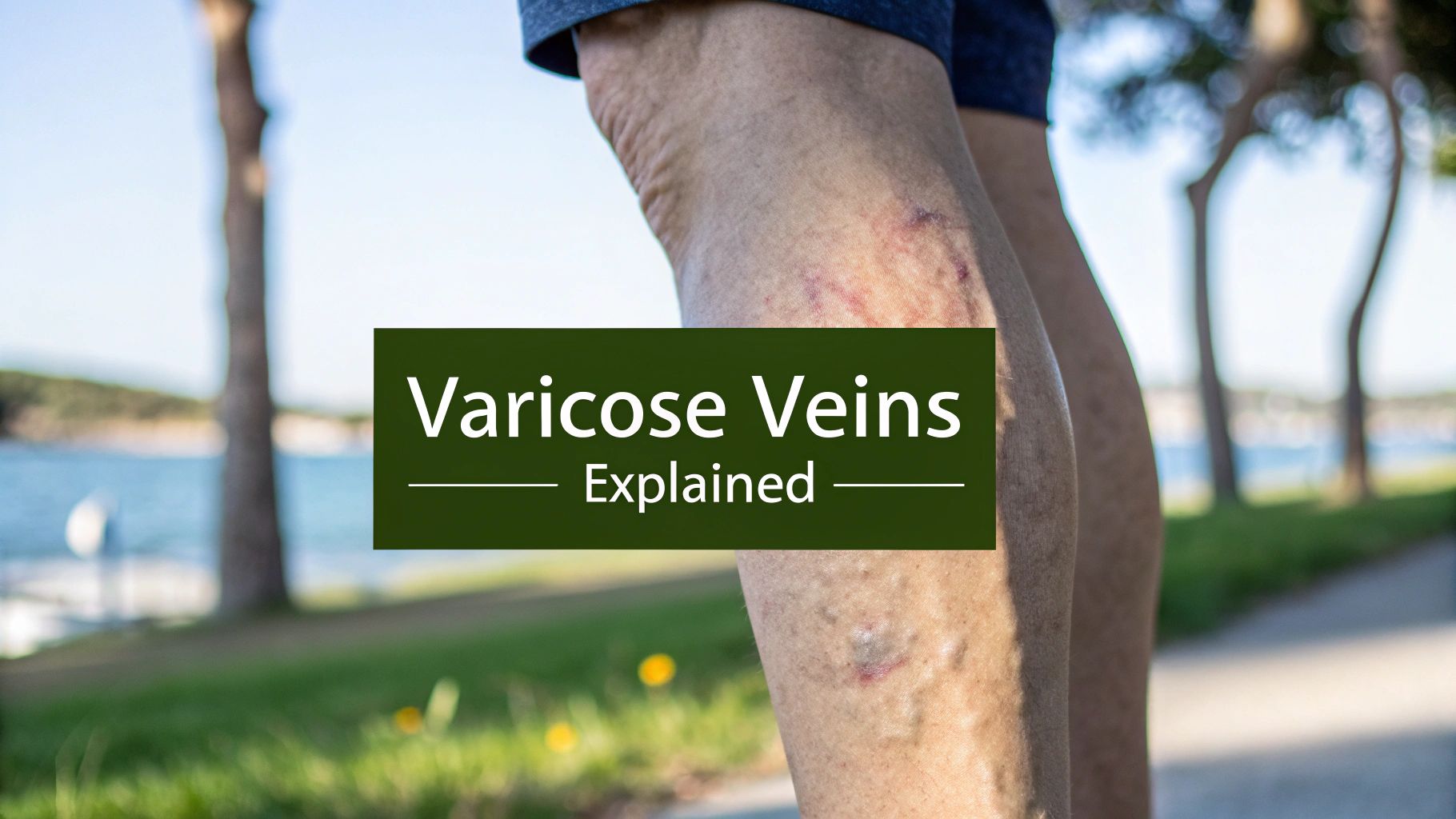
Think about the veins in your legs for a moment. They have a really tough job: pushing blood all the way back up to your heart, completely against gravity. To manage this, they’re lined with tiny, one-way valves that open to let blood flow upwards and then snap shut to stop it from falling back down.
Varicose veins appear when these little valves start to weaken or fail. Imagine a gate that doesn’t close properly. Blood begins to pool in the vein, which increases the pressure and causes the vein wall to stretch, twist, and bulge. That’s what creates the rope-like veins you can see on the surface.
Several things can make you more likely to develop them:
For decades, the go-to solution was surgical "vein stripping." This was a major operation that involved a hospital stay and a long, often painful, recovery. Thankfully, the world of varicose vein removal has moved on completely.
Modern treatments are minimally invasive, focusing on closing the faulty vein from the inside instead of surgically pulling it out. These are now simple walk-in, walk-out procedures done under local anaesthetic. That means less pain, virtually no scarring, and a much quicker return to your daily routine.
The goal today isn’t just to make your legs look better. It’s about relieving symptoms like aching, swelling, and heaviness and preventing long-term problems like skin discolouration or ulcers. It’s about restoring both your comfort and your confidence.
It's often useful to understand related venous conditions to get the full picture; for example, you can learn more from a comprehensive guide to hemorrhoids, which are actually another type of varicose vein. By understanding what causes the problem and the simple, effective solutions now available, you can feel much more empowered to take the next step. A great place to start is with our overview for new varicose vein patients.
If you’ve heard horror stories about painful vein stripping and long hospital stays, it’s time to forget them. Varicose vein treatment has been completely transformed over the last decade, moving away from major surgery towards clever, minimally invasive techniques that are far kinder to the body.
These modern procedures are efficient, require next to no downtime, and deliver fantastic results without the ordeal of a traditional operation.
The core principle is surprisingly simple. Instead of physically pulling the faulty vein out, the specialist seals it shut from the inside. Think of it like fixing a leaky pipe by sealing it from within, rather than digging up the whole floor to replace it. Once the vein is closed, your blood simply finds a new, healthier route. The treated vein is then gradually and naturally absorbed by your body.
What this means for you is a simple walk-in, walk-out procedure. Most treatments are done in an outpatient clinic using just a local anaesthetic, allowing you to get back on your feet and back to your life almost immediately.
Two of the most trusted and effective methods use thermal (heat) energy to close the vein. They're often considered the gold standard in modern vein care for their reliability and high success rates.
Both EVLA and RFA are incredibly successful, boasting success rates of over 95% in closing the main underlying faulty vein.
To help you get a clearer picture, here’s a simple breakdown of the most common procedures.
This table offers a side-by-side comparison of the most common minimally invasive treatments, helping you understand the key differences in procedure type, effectiveness, and recovery.
Ultimately, the right choice is a clinical decision based on a detailed scan of your unique vein anatomy.
While heat-based treatments are brilliant, they aren't the only option. Several excellent non-thermal methods achieve the same goal and can be perfect for veins that are particularly twisty or lie very close to the skin.
Key Takeaway: The goal of modern varicose vein treatment is always to close the faulty vein with minimal disruption to your body. This allows for a walk-in, walk-out experience, virtually no scarring, and a rapid return to your daily routine.
One of the most established non-thermal methods is Foam Sclerotherapy. Here, a specialist injects a medical foam directly into the varicose vein. The foam pushes the blood out and causes the vein lining to become sticky, making it collapse and seal. Over time, the body absorbs it. This technique is especially handy for smaller, winding veins that a catheter can't easily navigate. When looking into modern options, you may also come across advanced technologies like Aerolase laser treatment for veins, which targets smaller surface veins.
Another clever technique is VenaSeal, which uses a medical-grade adhesive. A tiny amount of this special glue is delivered into the vein via a catheter, sealing it shut almost instantly. The big advantage here is that patients often don't need to wear compression stockings after the procedure.
Choosing the right option is never a one-size-fits-all decision. Your specialist will perform a detailed ultrasound scan to map out your veins and recommend the most suitable and effective treatment plan for you.
Knowing what to expect can make the whole idea of varicose vein removal feel far less daunting. The entire process is designed to be clear, comfortable, and efficient, guiding you smoothly from your first chat with a specialist right through to a great result.
Think of this as your roadmap, showing you exactly what happens at each stage. It all starts not with a procedure, but with a conversation.
This first meeting is all about building a clear picture of your vein health. It’s your chance to talk through the symptoms you’re experiencing—whether that’s aching, swelling, itching, or simply how the veins look—and to ask absolutely anything that’s on your mind. A specialist will listen to your story and carry out a visual check of your legs.
But the most important part of this appointment is the duplex ultrasound scan. This is a completely painless, non-invasive scan that lets the specialist see exactly what’s going on under the skin. It’s like creating a detailed map of your veins, pinpointing which valves have failed and where the blood is flowing the wrong way.
This scan is essential because it takes all the guesswork out of the equation. It identifies the root cause of the problem, which is often a deeper, invisible vein. Only with this precise map can a specialist recommend the treatment plan that will work best for your unique situation.
The infographic below shows the key steps we take during this initial assessment.
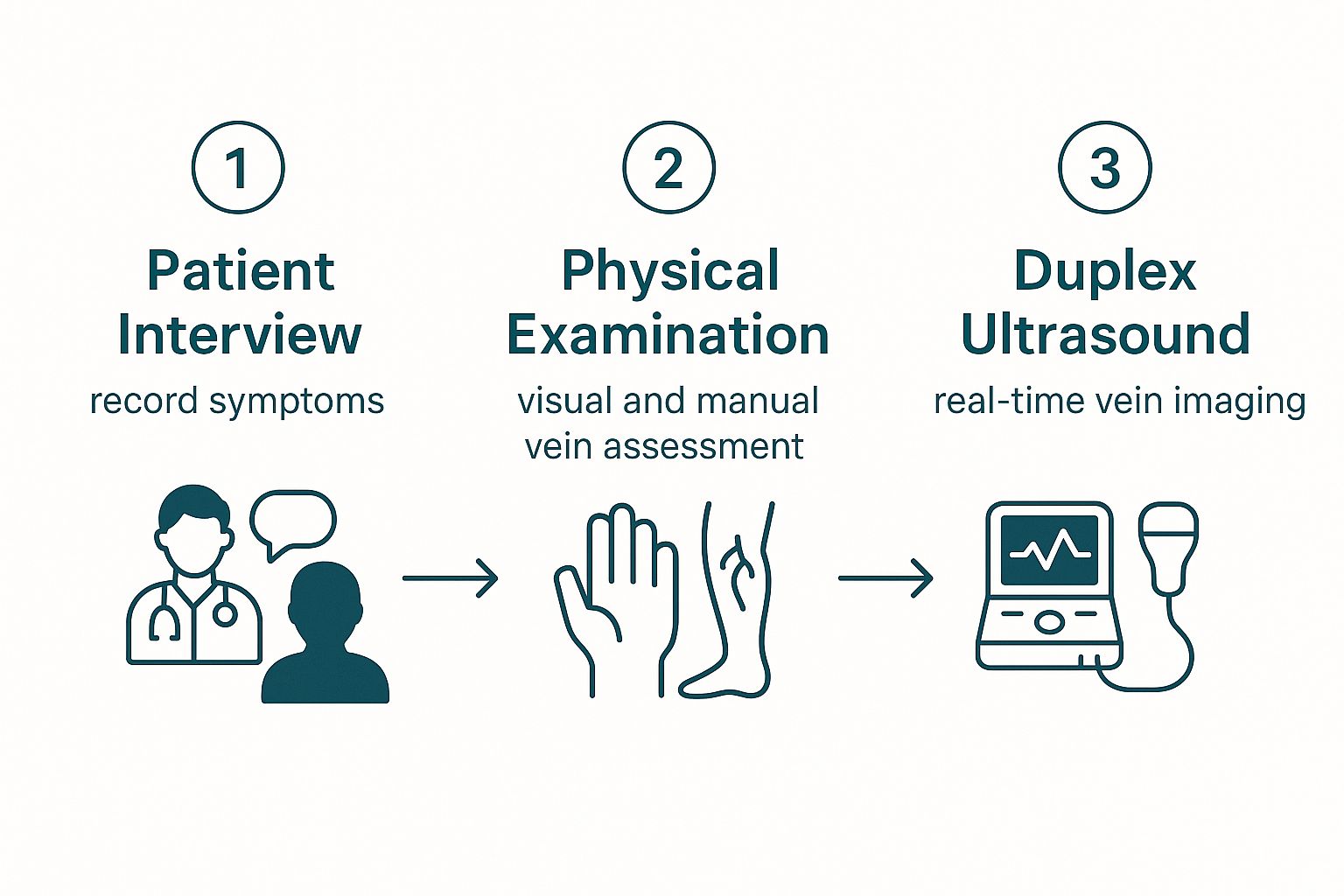
As you can see, it's the combination of listening to you, a physical examination, and advanced imaging that creates the complete diagnostic picture needed for perfectly targeted treatment.
Once your specialist has designed your treatment plan, the next step is getting ready for the day itself. The good news is, because modern varicose vein removal is so minimally invasive, preparation is usually very simple.
You'll get a few straightforward instructions, which normally include things like:
Your specialist will give you a full checklist to make sure you feel ready and confident. For a broader overview, our guide on how to prepare for surgery has some useful tips that apply to many minor procedures. Following these simple steps just helps make sure everything runs without a hitch.
On the day, you’ll arrive at the clinic, get settled into a treatment room, and the team will make sure you're comfortable and answer any last-minute questions. The specialist then uses a local anaesthetic to numb the area, so you’ll feel very little—often just a bit of pressure. The whole thing is typically over and done with in under an hour.
As soon as your treatment is finished, the recovery phase begins. You’ll be fitted with a compression stocking, which is a vital part of the healing process. Right away, you’ll be encouraged to get up and walk around to get your blood flowing properly.
Key Insight: The goal of recovery is gentle, consistent movement. Daily walking is one of the most important things you can do to support the healing process and ensure you get the best possible results.
Your specialist will book a follow-up appointment, usually a few weeks later. During this visit, they’ll perform another duplex ultrasound scan. This is simply to confirm that the treated vein has closed successfully and that your circulation has been cleverly rerouted through healthier veins.
This final check provides peace of mind and confirms the long-term success of your treatment. It's the last step on your journey to healthier, more comfortable legs.
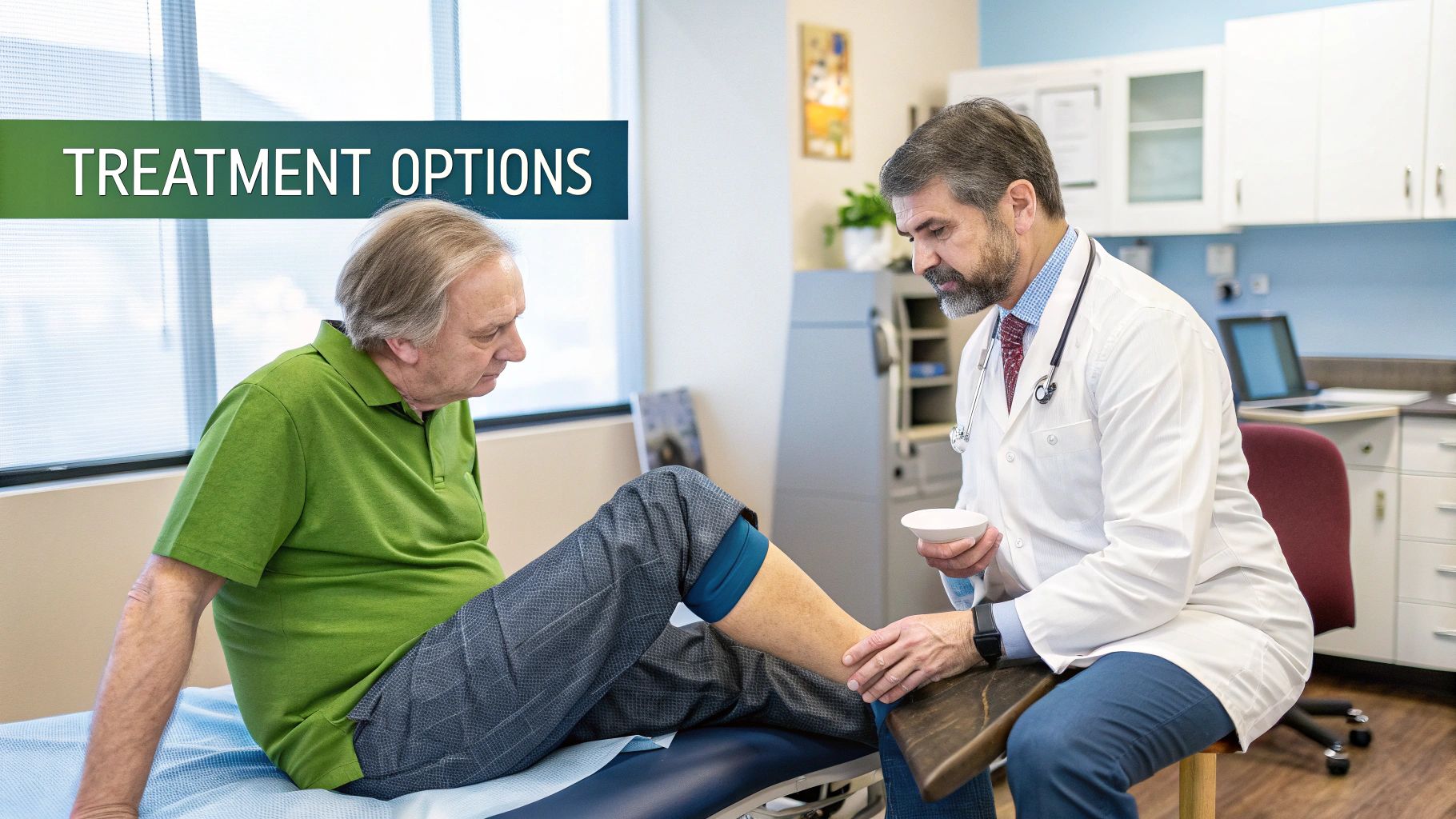 The journey doesn’t stop the moment you leave the clinic. While the procedure itself is the main event, it’s the recovery period that cements the long-term benefits and gets you back to living life with comfortable, healthier legs.
The journey doesn’t stop the moment you leave the clinic. While the procedure itself is the main event, it’s the recovery period that cements the long-term benefits and gets you back to living life with comfortable, healthier legs.
Knowing what’s coming up in the hours, days, and weeks that follow is the key to feeling in control and ensuring everything goes smoothly. Your recovery is designed to be straightforward, and following your specialist’s advice is the single most important thing you can do to get a fantastic result.
Immediately after your procedure, your specialist will fit a compression stocking on the treated leg. This isn’t just for show; it’s a crucial bit of medical kit. The consistent pressure it applies helps to keep bruising and swelling to a minimum, and, most importantly, it makes sure the treated vein stays firmly closed.
You’ll be encouraged to get up and walk around for about 10-15 minutes almost straight away. This might sound counterintuitive, but this gentle movement is vital. It gets the blood flowing properly and is the first real step on your path to recovery.
Recovery Insight: Don't think of recovery as bed rest. Think of it as a period of active, gentle movement. Daily walking is the best thing you can do to help the healing process along.
In the first couple of days, it's normal to feel a bit of tightness or a pulling sensation where the vein was treated. You'll likely see some bruising, too—sometimes it can look quite dramatic, but it’s perfectly normal and will fade away over a week or two. Any discomfort is usually mild and easily managed with over-the-counter painkillers like paracetamol.
Everyone’s journey is slightly different, and your specialist will give you personalised instructions. That said, most people follow a pretty similar timeline, which helps set realistic expectations.
Here’s a general idea of what to expect:
The initial recovery phase is quite short, but the benefits are built to last. Getting your varicose veins treated is about so much more than just how your legs look; it's about reclaiming your quality of life.
The most immediate change is the relief. That persistent aching, heaviness, and swelling that might have been bothering you for years will start to fade. This alone makes it possible to stand, walk, and go about your day with a newfound comfort you may have forgotten was possible.
Beyond the physical side, there’s a huge confidence boost. So many people feel self-conscious about their veins, avoiding shorts, skirts, or swimwear. Successful treatment gives you the freedom to feel good about your legs again. Ultimately, it’s about getting you back to the activities you love, without the discomfort and limitations that varicose veins once imposed.
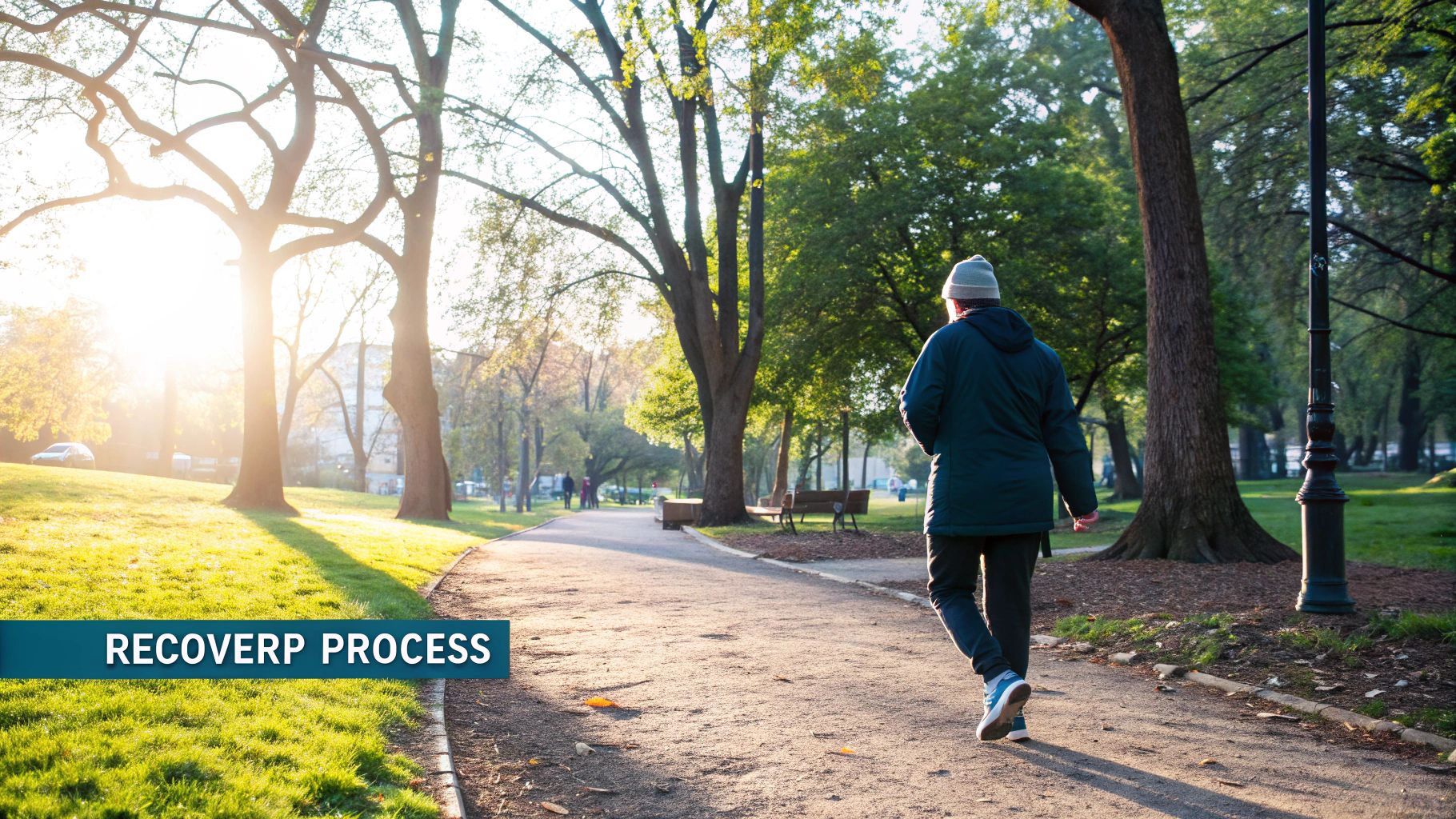
Making a good decision about your health always means looking at the full picture. When it comes to varicose vein removal, that means carefully balancing the life-changing improvements against the potential risks and the financial side of things. Having a clear view of all three lets you choose the path that truly feels right for you, your lifestyle, and your budget.
For many people, the decision to get treatment goes far beyond simply how their legs look. The real driver is often the chance to finally get relief from years of discomfort.
The most immediate reward of treatment is often the end of those persistent daily symptoms. That constant aching, throbbing, or heavy feeling in your legs can finally become a thing of the past. This alone brings a huge amount of comfort, whether you're standing, walking, or just trying to get through your day.
But there's more to it than just immediate relief. Treating varicose veins is a smart, proactive step for your long-term health. If left alone, the underlying venous issues can snowball into more serious problems over time, including:
By getting to the root of the problem, you dramatically lower your risk of these complications down the line. That peace of mind, combined with a welcome boost in confidence, makes treatment a genuinely worthwhile investment in your quality of life.
It’s completely natural to have questions about the downsides. The good news is that with today's minimally invasive techniques, the risks are very low and serious complications are rare. These procedures are carried out by specialists in a controlled clinical setting, with your safety being the top priority every step of the way.
Most of what people experience afterwards are temporary side effects that are just a normal part of the healing process. This usually means a bit of mild bruising, some tenderness, or a feeling of tightness where the vein was treated. Occasionally, a small patch of skin might feel temporarily numb, but this almost always resolves on its own within a few weeks.
Serious complications like deep vein thrombosis (DVT) or infection are extremely rare, with rates well below 1%.
A Balanced Perspective: While any medical procedure has some level of risk, modern varicose vein removal is overwhelmingly safe. The minor, temporary side effects are a small trade-off for the significant, long-term relief from pain and prevention of future health issues.
Your specialist will talk you through all the potential risks during your consultation, making sure you have a clear and realistic understanding before you decide to go ahead.
For most people, the final piece of the puzzle is the cost. In the UK, there are two main routes you can take for treatment: the NHS and private healthcare.
Getting varicose vein removal on the NHS is possible, but the criteria have become much stricter over the years. Generally, treatment is only approved if your symptoms are severe—think significant pain, skin changes, or leg ulcers. Unfortunately, if your case is deemed "cosmetic," it's unlikely to be funded.
This has led to more and more people choosing to go private to get treated sooner. In fact, the UK market for varicose vein treatment is growing steadily, largely driven by patients looking for these effective, less invasive options. It's estimated to be worth around USD 74.28 million in 2025, which shows just how many people are turning to private care.
Private treatment costs in the UK vary depending on how complex your case is and which procedure you need. A consultation, which includes a detailed duplex ultrasound scan, usually costs between £250 and £400. The treatment for one leg typically ranges from £2,000 to £4,000, and there's often a discount if you have both legs treated at the same time.
For a completely transparent breakdown of what to expect, you can take a look at our private treatment price list.
Even after getting to grips with the procedures and recovery, it's completely normal to have a few more questions rattling around. Deciding on any medical treatment is a big step, and feeling confident comes from having all the facts.
This final section tackles the questions we hear most often from our patients. We've pulled together the most common concerns to give you clear, straightforward answers and help you feel fully prepared.
This is usually the number one question, and thankfully, the answer is reassuring. Modern, minimally invasive treatments like Endovenous Laser Ablation (EVLA) and Radiofrequency Ablation (RFA) are done using a local anaesthetic.
Your specialist will completely numb the area around the vein. You might feel a bit of light pressure or a mild warming sensation during the procedure, but you shouldn't feel any real pain. It's a world away from the old surgical stripping methods, which needed a general anaesthetic and were known for being pretty uncomfortable.
Afterward, it’s normal to feel some mild discomfort, tightness, or bruising along the treated leg. Most people describe it as a dull ache, which is easily handled with over-the-counter pain relief like paracetamol. The main takeaway is that the entire experience is designed to be as comfortable as possible.
This is another critical question. No one wants to go through treatment only for the problem to reappear. It’s important to separate the idea of a treated vein recurring from new veins developing down the line.
When a vein is successfully closed with a modern technique like EVLA or RFA, it is permanently sealed. The success rates for these procedures are excellent, often over 95%, so the chance of that exact vein reopening is incredibly small. The sealed vein is simply absorbed by your body over time and is gone for good.
However, varicose veins are often the result of an underlying genetic tendency towards venous insufficiency. This means that, over many years, it's possible for new varicose veins to form in other parts of your legs.
Important Distinction: Successful treatment gets rid of the existing problem veins permanently. What it can't do is change your genetic predisposition. Maintaining a healthy lifestyle is a great way to help reduce the risk of new veins forming in the future.
Compression stockings are a vital part of your recovery, and nearly everyone asks how long they’re needed for. The typical advice is to wear the stocking continuously for the first 24 to 48 hours. After that, you’ll usually wear it just during the daytime for about one to two weeks.
But why are they so important? Think of the stocking as a supportive hug for your leg. It does three key things:
They might feel a little odd at first, but wearing your stockings as directed is one of the single best things you can do for a smooth recovery and the best possible result.
Most people are pleasantly surprised by how quickly they can get back on their feet. The exact advice you get will depend a little on the type of work you do and your specific treatment.
Here are the general guidelines:
The demand for these treatments is significant. In the UK, varicose vein procedures are a major area of healthcare. To give you some context, during the 2009/10 fiscal year, the NHS carried out approximately 35,659 varicose vein procedures, which really highlights the clinical need. You can read more in the full research about NHS varicose vein procedure statistics.
Ultimately, your specialist will give you personalised advice for your situation. The goal is always to get you back to doing what you love, safely and with confidence. For more details on the specialists who perform these procedures, you can explore our overview of vascular surgery experts.
At The Vesey, our team is dedicated to providing exceptional care and clear, honest guidance. If you have more questions or are ready to discuss your options, we invite you to book a consultation with one of our specialists. Visit us at https://www.thevesey.co.uk to take the next step towards healthier, more comfortable legs.

